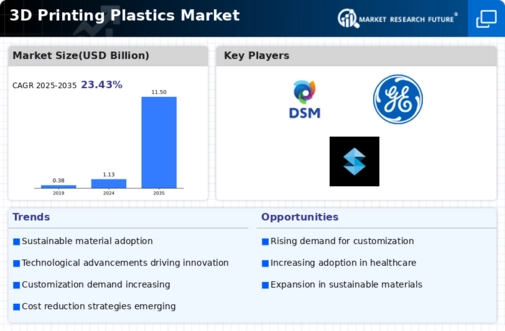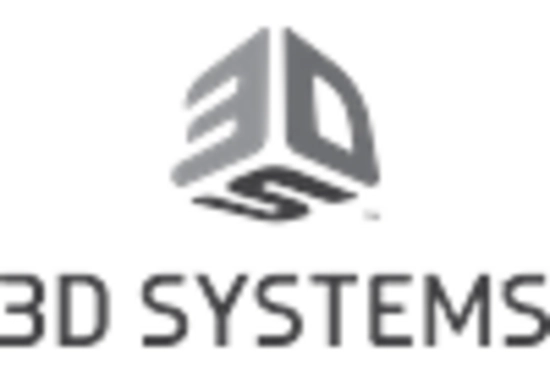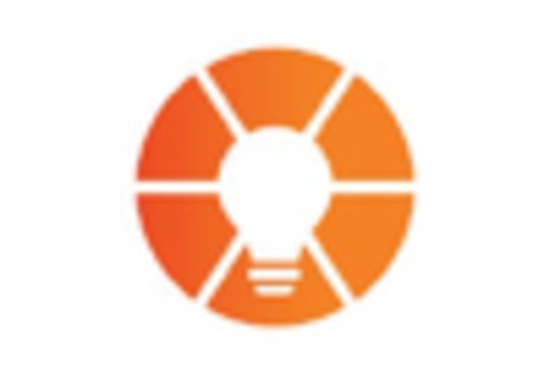Market Share
3D Printing Plastics Market Share Analysis
In the competitive landscape of the 3D Printing Plastics market, companies employ a variety of market share positioning strategies to differentiate themselves and gain a competitive edge.
Product Innovation and Customization: Companies focus on developing innovative 3D printing plastic materials with unique properties and functionalities. By offering a wide range of materials, including ABS, PLA, PETG, and nylon, with varying characteristics such as strength, flexibility, and heat resistance, companies cater to the diverse needs of different industries and applications. Customization options, such as color variations and specialty additives, allow companies to tailor their products to specific customer requirements, thereby gaining a larger market share.
Industry-Specific Solutions: Tailoring 3D printing plastics to meet the specific needs of different industries is a key strategy for market share positioning. Companies develop materials optimized for various applications, including aerospace, automotive, healthcare, consumer goods, and electronics. By understanding the unique requirements and performance demands of each sector, companies can offer specialized solutions that address industry-specific challenges, leading to increased market share in targeted segments.
Geographic Expansion and Market Penetration: Expanding into new geographic markets or strengthening presence in existing markets is essential for market share growth. Companies establish local distribution networks, partnerships, or manufacturing facilities to better serve regional customers and increase market reach. By being closer to customers and providing localized support, companies can enhance customer relationships and gain market share in key territories.
Strategic Partnerships and Collaborations: Forming strategic partnerships or collaborations with other industry players is crucial for market share positioning in the 3D printing plastics market. Companies collaborate with material suppliers, 3D printer manufacturers, software developers, and end-users to develop new products, technologies, and applications. Strategic alliances enable companies to leverage complementary capabilities, access new customer segments, and gain market share more effectively than operating independently.
Focus on Sustainability and Environmental Responsibility: With increasing emphasis on sustainability and environmental responsibility, companies prioritize the development of eco-friendly 3D printing plastics. By offering biodegradable, recyclable, or bio-based materials, companies appeal to environmentally conscious customers and gain market share. Investing in sustainable manufacturing practices, such as energy-efficient production processes and closed-loop recycling systems, further enhances brand reputation and competitiveness in the market.
Investment in Research and Development (R&D): Continuous investment in R&D is critical for maintaining a competitive edge in the 3D printing plastics market. Companies focus on developing new materials, improving existing formulations, and enhancing manufacturing processes to meet evolving customer needs and market trends. R&D efforts aim to optimize material properties, such as strength, durability, and printability, enabling companies to differentiate themselves from competitors and gain market share through superior product performance.
Customer Relationship Management (CRM): Building strong relationships with customers is essential for market share growth. Companies provide excellent customer service, technical support, and training programs to enhance customer satisfaction and loyalty. By understanding customer requirements and offering personalized solutions, companies can strengthen customer relationships and increase market share through repeat business and referrals.
Brand Building and Reputation Management: Establishing a strong brand reputation and positive industry reputation is crucial for gaining market share in the 3D printing plastics market. Companies that are recognized for quality, reliability, and innovation are more likely to attract customers and command higher market share. Investing in brand building activities, such as advertising, trade shows, and public relations, helps companies enhance brand visibility and differentiate themselves from competitors.
Competitive Pricing and Value Proposition: Competing on price while maintaining product quality and value is another strategy used by companies to gain market share. Companies offer competitive pricing relative to competitors and highlight the value proposition of their 3D printing plastics, such as printability, compatibility with different printers, and post-processing capabilities. By offering cost-effective solutions that meet customer needs, companies can win business and increase market share.
Continuous Monitoring and Adaptation: Companies must continuously monitor market trends, competitive activities, and customer feedback to adapt their market share positioning strategies accordingly. By staying agile and responsive to changes in the market environment, companies can capitalize on emerging opportunities, address evolving customer needs, and maintain a competitive advantage in the dynamic 3D printing plastics market. Regular assessment and adjustment of market share positioning strategies are essential for long-term success and growth in the industry.

















Leave a Comment